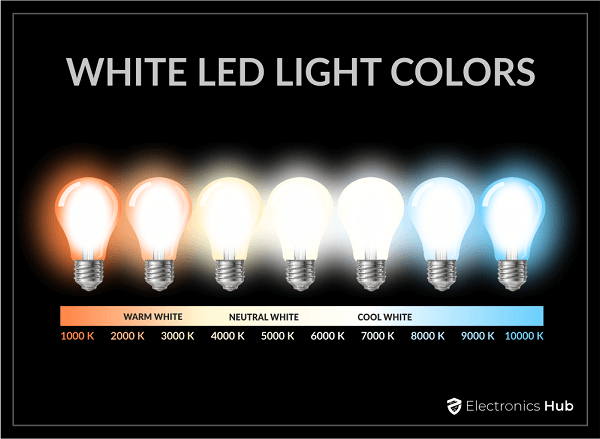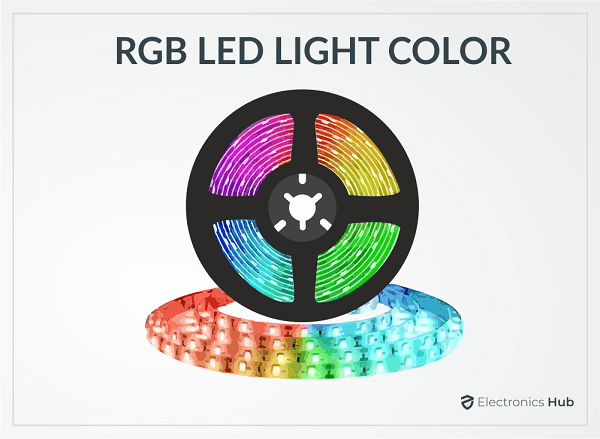A Brief Note on LEDs
LEDs are efficient, reliable, small, bright, rugged. As a result, they became the primary source of lighting in our homes where we replaced the incandescent and fluorescent (some still use them) with LED Lighting. But do you know that earlier LEDs produced so less brightness that we used them only as indicator lights. But now-a-days, we have LEDs lighting up stadiums. Apart from the brightness and efficiency, another important feature of LED Lights is its colors. LEDs can produce different colors of light and also different color temperatures. The easiest way to produce different colors is to use a white LED and cover (surround) it with a color filter. While there are some small LEDs that do this, we can naturally produce real colors from the LED itself. This is an excellent and important feature of LEDs that no other lighting system has.
About LED Light Colors
We spend a large amount of under artificial lighting and now-a-days the source of this artificial lighting is LEDs. Since the color of the light is very important to set the tone of the room and even affects our psychological behavior, it is critical that we get/choose the right LED Light Colors. For example, in offices, we tend to use light color that is slightly close to the neutral or cool white to keep us active whereas in kitchen and dining room, we use a bright and slightly warmer tone of white to see things clearly and also create an ambience.
White LED Light Colors
Let us begin with the most popular and most widely used LED Light Color: White. To be more specific, we use several shades of White, which are:
Warm White Soft White Neutral White Cool White Daylight
All these LED Light Colors are actually available but perhaps with slightly technical names. Instead of using warm white, cool white etc. manufacturers use color temperatures to represent the scale of white the LED Light can produce.
In couple of earlier guides, we saw comparison of 3000K vs 4000K as well as 4000K vs 5000K Color Temperatures.
Warm White: 2200K – 2700K Soft Warm White: 2700K – 3000K Neutral White: 3000K – 3500K Cool White: 4000K – 5000K Daylight: 5500K – 6500K Anything beyond 6500K appears increasingly blue in color
Warm White usually gives an intimate and romantic feeling. Hence, this type of lighting is best suitable for bedrooms and restaurants. We generally use Soft Warm White lights is hospitality situations to create a warm atmosphere. Neutral and Cool White Lights start to show some blue in them. Hence, we use them in offices, retail spaces, kitchens, living rooms etc. to keep use alert, focused and productive. We can also use bright daylight LEDs in hospitals, gyms, museum, showrooms and other similar places where we need to highlight each and every single detail as clearly as possible.
RGB LED Light Color
While White and its shades are the traditional lighting, you can make your life colorful with fancy RGB LED Lights. We normally don’t use Red, Green, Blue or other color lights as main lighting but either as decorative lights, highlighting lights, cars and other signages. The most common and popular choice of RGB Lights is RGB LED Light Strips. There are two types of strips: one is simple RGBLED Strip where all the LEDs in the strip produce the same color and an RGBIC LED Strip that can produce multiple colors from the same strips at the same time. Learn more about RGBIC vs RGB LED Strip Lights.
What are the Moods of LED Light Colors?
An important feature of different tones of lighting is that they create certain psychological and emotional responses and feelings, similar to good food and smell. For example, warm white brings out warmth, calming and cozy feeling and you feel like opening up yourself. A cool white or daylight on the other hand is slightly bluish in nature and hence it brings out focus and alertness in you. Similarly, other color lights bring some sort of emotional response from you. We listed some of them in the following table.
Conclusion
Getting the right LED Light Colors is very important as it has an impact on us in an emotional way. A good color light will bring out a good mood in you. That said, we don’t have to use fancy colorful RGB Lights but different shades of white make the job very easy. We can RGB Lighting to highlight or decorate areas of home, car, retail space. Comment * Name * Email * Website
Δ








![]()